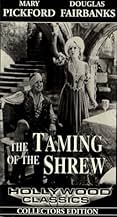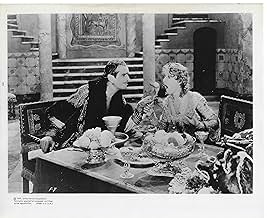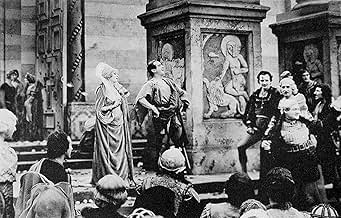NOTE IMDb
6,3/10
691
MA NOTE
À Padoue, Baptista désespère de trouver un mari qui puisse résister au caractère colérique de sa fille aînée Catherine. Un jour, Petruchio, un marchand ruiné originaire de Vérone débarque af... Tout lireÀ Padoue, Baptista désespère de trouver un mari qui puisse résister au caractère colérique de sa fille aînée Catherine. Un jour, Petruchio, un marchand ruiné originaire de Vérone débarque afin de chercher richesse et femme.À Padoue, Baptista désespère de trouver un mari qui puisse résister au caractère colérique de sa fille aînée Catherine. Un jour, Petruchio, un marchand ruiné originaire de Vérone débarque afin de chercher richesse et femme.
- Réalisation
- Scénario
- Casting principal
- Récompenses
- 2 victoires au total
Wilson Benge
- Servant
- (non crédité)
Frankie Genardi
- Little Boy
- (non crédité)
Billie Jeane Phelps
- Little Girl
- (non crédité)
Charles Stevens
- Servant
- (non crédité)
Avis à la une
Early Hollywood's most famous couple, Mary Pickford and Douglas Fairbanks, decided to collaborate on a film in an attempt to patch up their growing distant marriage. The play they chose to adapt to the screen, a Shakespearean one, wasn't probably the best choice in healing their tumultuous alliance. The loosely-adapted work, October 1929's "The Taming of the Shrew," focused on a fiery, mean-spirited woman wooed by a nobleman who attempts to calm her down. The movie was Fairbanks' first talking picture while it was Pickford's second. The critics were split as to how each passed the test making the transition to spoken dialogue films.
Variety was upbeat on "The Taming of the Shrew," commenting "While there is plenty of romance and dialog, slapstick and mud, there's no dirt, so that part of Pickford's career remains as clean as ever. Splendid settings in the Fairbanks massive production manner." Modern assessments of the film are less than praiseworthy, especially knowing in hindsight that both careers took a deep dive after the "Shrew." Says Leonard Maltin, the movie "was defeated by its lack of pacing and downright embarrassing performances, though it's undeniably fascinating to see Doug and Mary together in their only co-starring appearance." Years later, Pickford said it was her worst performance of her life. She did admit, however, that Fairbanks excelled as his portrayal of Petruchio.
"The Taming of the Shrew" was the first Shakespearian play brought to the screen as a talkie. The feature film was based more on the Richard Garrick's version of the farce, his 'Katherine and Petruchio.' The 1929 film incorporates about 20 percent of Shakespeare's written dialogue, and the movie's English, still Elizabethan, is updated somewhat to make it more understandable for the modern audiences.
Today's viewers to "The Taming of the Shrew" will take notice that Fairbanks' harsh treatment of Katherine is so over-the-top many felt back then the actor was taking out all his frustrations of the couple's personal relationship out on her. And Pickford's punchy attitude was equally demonstrative by her excessive yelling and physicality towards him, portions that were not written in the script. Pickford claims all the fault laid at the director, Sam Taylor's feet, a surprising allegation since both he and the actress got along swimmingly during their last collaboration, 1927's "My Best Girl."
As one reviewer noted, "The acting that had made Pickford and Fairbanks the 'King and Queen of Hollywood' rendered their performing style obsolete overnight. It's important to remember, of course, that the change brought about by sound had absolutely nothing to do with their deficiencies as performers, but only emphasizes the differences between silent and sound film. Watching a film like 'The Taming of the Shrew,' and comparing it to what they were both doing just months earlier, makes a strong case that the silent and sound film are really two entirely different things."
Variety was upbeat on "The Taming of the Shrew," commenting "While there is plenty of romance and dialog, slapstick and mud, there's no dirt, so that part of Pickford's career remains as clean as ever. Splendid settings in the Fairbanks massive production manner." Modern assessments of the film are less than praiseworthy, especially knowing in hindsight that both careers took a deep dive after the "Shrew." Says Leonard Maltin, the movie "was defeated by its lack of pacing and downright embarrassing performances, though it's undeniably fascinating to see Doug and Mary together in their only co-starring appearance." Years later, Pickford said it was her worst performance of her life. She did admit, however, that Fairbanks excelled as his portrayal of Petruchio.
"The Taming of the Shrew" was the first Shakespearian play brought to the screen as a talkie. The feature film was based more on the Richard Garrick's version of the farce, his 'Katherine and Petruchio.' The 1929 film incorporates about 20 percent of Shakespeare's written dialogue, and the movie's English, still Elizabethan, is updated somewhat to make it more understandable for the modern audiences.
Today's viewers to "The Taming of the Shrew" will take notice that Fairbanks' harsh treatment of Katherine is so over-the-top many felt back then the actor was taking out all his frustrations of the couple's personal relationship out on her. And Pickford's punchy attitude was equally demonstrative by her excessive yelling and physicality towards him, portions that were not written in the script. Pickford claims all the fault laid at the director, Sam Taylor's feet, a surprising allegation since both he and the actress got along swimmingly during their last collaboration, 1927's "My Best Girl."
As one reviewer noted, "The acting that had made Pickford and Fairbanks the 'King and Queen of Hollywood' rendered their performing style obsolete overnight. It's important to remember, of course, that the change brought about by sound had absolutely nothing to do with their deficiencies as performers, but only emphasizes the differences between silent and sound film. Watching a film like 'The Taming of the Shrew,' and comparing it to what they were both doing just months earlier, makes a strong case that the silent and sound film are really two entirely different things."
While it's far from perfect either as a movie or as an adaptation of Shakespeare, this version of "The Taming of the Shrew" is enjoyable as light entertainment. It also offers a rare chance for silent film fans to see Mary Pickford and Douglas Fairbanks together, in a sound feature no less. Fairbanks has a role much more suited to him than does Pickford, but it's still good to see them together.
Petruchio really is quite a suitable role for Fairbanks, and his buoyant confidence works well. His portrayal seems to be pretty close to the kind of character that Shakespeare intended. The role of Katherine doesn't give Pickford a chance to use her greatest strengths. She does project good energy, and has plenty of charm when it is called for, but at times her portrayal doesn't seem to fit the original conception of the character, and the role definitely did not give Mary the chance to display her wide range of talents with more subtle material.
The story is a rather loose, jaunty adaptation of the original, and there would be little point in making detailed comparisons. As a movie, most of it works all right aside from the occasional instances of awkwardly-paced dialogue and the like that are characteristic of so many films of the early sound era. Fairbanks does help make some of these moments less noticeable with his obvious good humor. There are certainly a number of obvious ways in which it could have been better, and it's fair to point them out. Yet it still has enough of the classic story, plus enough of its own energy, to make it worth seeing as long as you know what to expect.
Petruchio really is quite a suitable role for Fairbanks, and his buoyant confidence works well. His portrayal seems to be pretty close to the kind of character that Shakespeare intended. The role of Katherine doesn't give Pickford a chance to use her greatest strengths. She does project good energy, and has plenty of charm when it is called for, but at times her portrayal doesn't seem to fit the original conception of the character, and the role definitely did not give Mary the chance to display her wide range of talents with more subtle material.
The story is a rather loose, jaunty adaptation of the original, and there would be little point in making detailed comparisons. As a movie, most of it works all right aside from the occasional instances of awkwardly-paced dialogue and the like that are characteristic of so many films of the early sound era. Fairbanks does help make some of these moments less noticeable with his obvious good humor. There are certainly a number of obvious ways in which it could have been better, and it's fair to point them out. Yet it still has enough of the classic story, plus enough of its own energy, to make it worth seeing as long as you know what to expect.
The theatre provided a lot of material for early sound theatre, so it was a matter of course that fairly soon someone would use the new talkie medium to take on Shakespeare. But which of his plays would be the first to be adapted? One of the famous tragedies – Hamlet, MacBeth, Romeo and Juliet? No. It was lightweight comedy The Taming of the Shrew, a play which unfortunately sees the bard at his most misogynistic.
The movie was a vehicle for real-life husband and wife Douglas Fairbanks and Mary Pickford, he in his first talkie, she in her second. Given the state that their marriage had degenerated into by this point, the storminess between the two of them probably wasn't that far from the truth. They both act well it has to be said, hamming it up magnificently in a manner drawing upon their experience both in stage and silent cinema, and which you can only really get away with in the context of this play's comical theatricality.
The director is Sam Taylor, a man with a background in comedy, who helmed the finest Harold Lloyd movies during the silent era. The Taming of the Shrew sees him returning to his roots, staging the verbal comedy as broad slapstick. Taylor is a master of the pull-back-and-reveal gag, making us think one thing then punch-lining us with another. In adapting the play, he pares down Shakespeare's dialogue, and reduces it for the most part to a poetic backdrop, allowing the comic vignettes to tell the story. This is quite something, because this style of physical comedy more or less died out when the talkies came along, but here Sam Taylor is showing a way it could have continued.
But what is also intriguingly good about this version of The Taming of the Shrew is its sly subversion of Shakespeare's misogyny. The bard's lines remain what they are, but the action in between them is enough to tweak their message. Pickford is brilliantly sarcastic for Katherine's final speech, and as Fairbanks sits beside her with a large bandage on his head, it becomes clear who's taming whom.
The movie was a vehicle for real-life husband and wife Douglas Fairbanks and Mary Pickford, he in his first talkie, she in her second. Given the state that their marriage had degenerated into by this point, the storminess between the two of them probably wasn't that far from the truth. They both act well it has to be said, hamming it up magnificently in a manner drawing upon their experience both in stage and silent cinema, and which you can only really get away with in the context of this play's comical theatricality.
The director is Sam Taylor, a man with a background in comedy, who helmed the finest Harold Lloyd movies during the silent era. The Taming of the Shrew sees him returning to his roots, staging the verbal comedy as broad slapstick. Taylor is a master of the pull-back-and-reveal gag, making us think one thing then punch-lining us with another. In adapting the play, he pares down Shakespeare's dialogue, and reduces it for the most part to a poetic backdrop, allowing the comic vignettes to tell the story. This is quite something, because this style of physical comedy more or less died out when the talkies came along, but here Sam Taylor is showing a way it could have continued.
But what is also intriguingly good about this version of The Taming of the Shrew is its sly subversion of Shakespeare's misogyny. The bard's lines remain what they are, but the action in between them is enough to tweak their message. Pickford is brilliantly sarcastic for Katherine's final speech, and as Fairbanks sits beside her with a large bandage on his head, it becomes clear who's taming whom.
This early sound movie blows a hole in the theory that all sound films from this era were static, clumsy affairs due to the camera being imprisoned in a soundproof booth to avoid the sound of its machinery registering on the microphones. The camera is very fluid in this otherwise ordinary adaptation of Shakespeare's play.
Hollywood royalty Douglas Fairbanks and Mary Pickford star as Kate and Petruchio, the warring couple who really love each other on the sly. Their marriage was a sham by the time this flick came out, and both their careers were on the wane, but they give reasonable enough performances, even though Fairbanks looks a few years too old for his part when the camera gets close. There's still a tendency to exaggerate their gestures and overact to responses to words being spoken, but they're no worse than any other stars making their first sound films.
It's clear that Hollywood back then had no more confidence in the intelligence of its audience than it does today: this is Shakespeare for the common man, with the pith of the Bard's prose removed in order to make the words readily understandable to all. Although the film is little more than an hour long, it does begin to drag during the last twenty minutes but, that aside, it's not a bad effort.
Hollywood royalty Douglas Fairbanks and Mary Pickford star as Kate and Petruchio, the warring couple who really love each other on the sly. Their marriage was a sham by the time this flick came out, and both their careers were on the wane, but they give reasonable enough performances, even though Fairbanks looks a few years too old for his part when the camera gets close. There's still a tendency to exaggerate their gestures and overact to responses to words being spoken, but they're no worse than any other stars making their first sound films.
It's clear that Hollywood back then had no more confidence in the intelligence of its audience than it does today: this is Shakespeare for the common man, with the pith of the Bard's prose removed in order to make the words readily understandable to all. Although the film is little more than an hour long, it does begin to drag during the last twenty minutes but, that aside, it's not a bad effort.
This film essentially begins with a young man named "Horentsio" (Geoffrey Wardwell) desiring to marry a woman by the name of "Bianca" (Dorothy Jordan) who is the daughter of a wealthy man named "Baptista" (Edwin Maxwell). The only problem is that Baptista refuses to give Bianca away in marriage until her older sister "Katherine" (Mary Pickford) is wed first. And therein lies the rub as nobody--and I mean absolutely nobody--wants to marry Katherine as she has an extreme temper and a generally bad disposition all around. However, as luck would have it, just when both Horentsio and Baptista think the situation is hopeless, along comes a superbly confident young man named "Petruchio" (Douglas Fairbanks) who is not only excited about the challenge but also thinks quite highly of the dowry which he will acquire should he marry Katherine. For her part, Katherine wants nothing to do with Petruchio and for that reason she intends to make things as difficult as possible for all concerned. Now, rather than reveal any more, I will just say that this film deviated quite substantially from the actual play by William Shakespeare. That being said, while I don't normally like Hollywood adaptations, I thought that this one turned out quite well--all things considered. I especially liked the over-the-top facial expressions by both Mary Pickford and Douglas Fairbanks which were, no doubt, a product of the transition from silent films to those incorporating sound. Be that as it may, I enjoyed this movie and I have rated it accordingly. Above average.
Le saviez-vous
- AnecdotesIn her later years, Mary Pickford stated that working on the film was the worst experience of her life, although she also acknowledged that Douglas Fairbanks's performance was one of his best.
- Versions alternativesAfter many years out of circulation, the film was re-released in 1966 in a new cut supervised by Mary Pickford herself. New sound effects were added throughout, much of the voice dubbing was enhanced with newly available technology, and seven minutes were cut from the initial print. This re-released version is the only version now available on DVD or VHS.
- ConnexionsFeatured in Mary Pickford: A Life on Film (1997)
Meilleurs choix
Connectez-vous pour évaluer et suivre la liste de favoris afin de recevoir des recommandations personnalisées
Détails
Box-office
- Budget
- 504 000 $US (estimé)
- Durée
- 1h 3min(63 min)
- Couleur
Contribuer à cette page
Suggérer une modification ou ajouter du contenu manquant





























